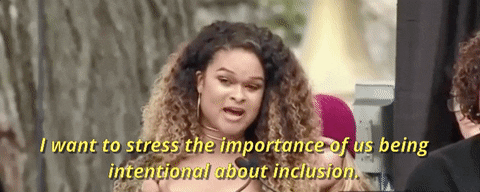Pack your backpack, not your briefcase: fostering workplace inclusion post-pandemic

Fostering workplace inclusion in a post-pandemic work environment can lead to a more positive workplace culture, better employee mental health, and higher productivity levels.
Our lives and relationships to work have changed so much over the past year. Prior to the pandemic, a lot of people seemed to live two very separate lives. They would have their home lives filled with family, friends, pets, activities and casual clothes, and then they had their work life comprised of professionalism, ironed shirts and productivity. When leaving the house for work each day many people would race out the door, quickly shutting it behind them ensuring that their home-self remained securely inside. But why?
Historically, there has been a corporate-driven belief stating that bringing your whole self to work is unprofessional. If you were dedicated to your job, your home self stayed back, patiently waiting for your arrival once the day was done. Even though this has been the historical practice, it did not lend well to an inclusive workplace.
What is workplace inclusion and why is it important?
Essentially, an inclusive workplace is a working environment where every employee feels valued while also having their individualism acknowledged. An inclusive organisation recognises that everyone’s individual attributes directly contribute to the organisation’s culture and business outcomes.
Inclusion should be considered a key focus area for businesses for a number of reasons:
- Inclusion helps to create a more positive workplace culture where everyone feels happy and excited to come to work
- Teams can collaborate and function more effectively when they know and understand their members
- A sense of inclusion is great for employee mental health and wellbeing
- Inclusion can lead to increased productivity as people feel valued and enjoy their work
- Individuals feeling comfortable being their authentic selves at work helps to establish trust
- An inclusive culture can decrease staff turnover rates
In order for one to feel a real sense of inclusion at work, employees must feel a sense of belonging and uniqueness. If someone feels seen, valued and accepted by the team for their own unique characteristics, they feel more included in the group dynamic.

For example, Jane has several hobbies but her most practiced one is Brazilian Jiu-Jitsu. Her team members love asking her about her training because they genuinely find it interesting and unique to anything they do themselves. This kind of interest from Jane’s co-workers makes her feel seen and valued for who she is, leading to a feeling of inclusion.
Team members feel a stronger sense of belonging at work if they feel valued as a member of the team. For example, when Seth came down with a cold and had a couple of days off work, his team members noticed his absence immediately when he didn’t attend the weekly scheduled meeting. They sent him a couple of messages checking in on him and wishing him a speedy recovery.
Jane and Seth’s organisations didn’t foster this kind of inclusive culture by keeping everyone at an arm’s length for the sake of professionalism. They brought their whole selves to work and allowed their co-workers to learn about their unique characteristics.
Remote work makes the heart feel… included?
Although it seems very old school, there are many businesses out there that are still holding onto the “no personal lives at work” kind of culture. Since the pandemic however, that way of working has been completely smashed to pieces. Even the most traditional of organisations were forced to get to know their colleagues a little better.
With remote work firmly in place, we have all been guests in each other’s homes. We have sat quietly within our individual Zoom squares, taking in the sights. We met (and talked to) each other’s pets, and chuckled as dressing-gown clad partners scooted past, coffee in hand. We even saw parents soothing children after home-schooling tantrums.

Each one of these scenarios are intimate moments, typically shared between only the closest of family and friends. Suddenly, your co-workers were now daily witnesses to these everyday rituals and environments.
We got to know our co-workers on levels that we would never have had the chance to before. We suddenly had a myriad of different conversation topics, questions, and things to be updated on weekly. We were isolated, kept away from our big, beautiful lives and so our on-screen connections and windows into each other’s lives became the most important forms of connection we had.
Everyone was being seen as the unique individuals that they were, and suddenly felt more valued than ever before. What was mundane to us, became of interest to others.
Bringing inclusion back to the office.
Now begs the question: once we return to the office, what do we do with all of the personal information we have gathered throughout our pandemic video conference time? There is no ‘delete all’ function for our brains to execute, there are no men in black to flash a device in our eyes and erase our memories. How do we intend to return to the office and slot straight back into the professional environment?
The answer is that we simply shouldn’t.
Our productivity didn’t plummet because we gave updates on feline Fluffy’s leg operation. We didn’t lose our co-workers’ respect after being seen in activewear. We also didn’t suddenly lose all our skills because our child screamed down the microphone and chatted about his favourite dinosaur.
Getting to know one another on deeper levels has elevated our sense of inclusion in the workplace, even though we ironically, haven’t been in the physical workplace environment at all.

How to foster post-pandemic workplace inclusion.
As we all return to the office, we must pack our backpacks with empathy, vulnerability and real-life stories and leave our briefcases full of superficiality at home. We spent such a long time fostering those connections and building our culture of inclusion, here’s how we can keep it up in the real world:
- Move beyond the superficial: During the pandemic we have learned what makes us unique. Continue to ask questions relating to what you know about that person. For example, “Where are you up to in Handmaids Tale, what did you think of xx”, “How is your daughter going with her internship?”, “Is the indoor plant still alive?”.
- Be more open: It’s one thing to ask lots of questions, but we all know that conversations are a two-way street. When conversations are happening in the office, chime in about how you can relate to the topic also. Be willing to share a little more about yourself, don’t be afraid to get personal.
- Continue the conversation around mental health: When we were working remotely and trying to get used to our new COVID-19 lives, it seemed much more acceptable to ask how people were travelling. Keep doing this. Even when we are on the other side of the worst part of the pandemic, mental health concerns can and will still arise. Checking in on your colleagues will help them feel valued and included.
Here at Interchange, we want to help you foster an inclusive workplace that your employees will love to be a part of. Fill out our contact form and a member of our team will be in touch soon!